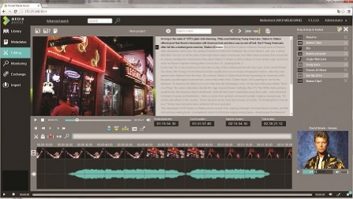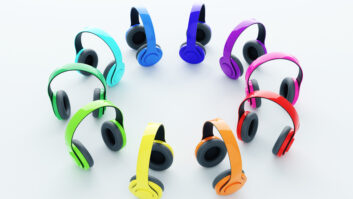PRODUCT CAPSULE
(click thumbnail)Magix Audio Cleaning Lab 11
(click thumbnail) The de-click and de-crackle sliders removed scratches in real time and without creating artifacts.
(click thumbnail)The software offers Brilliance Enhancer and Soundcloner features. Soundcloner imports spatial reverb characteristics from one file to another.
Magix Audio Cleaning Lab 11
THUMBS UP:
Tons of features
‘All-in-one’ package for importing audio, repairing and arranging it and mastering a CD
Surprising array of restoration tools not found in most editing packages
Low cost
THUMBS DOWN:
Not as flexible as high-priced systems in its parameters and options
Operation clunky and non-intuitive in some sections, though ‘one-click’ options help
Some features not top-of-the-line
PRICE: $40
CONTACT: Magix Entertainment Corp. in Miami at (305) 642-6300 or visit http://www.magix.com.
I admit that I am an audio restoration snob.
For 10 years I’ve used CEDAR noise reduction and de-click modules as part of my SADiE hardware/software system. Many professionals consider these to be the best British imports since the Beatles, and I probably spent $20,000 on the initial gear and upgrades over the years.
When I was assigned to write a review of a $40 German software package that claims to restore old vinyl records and tapes, I had low expectations. This would be like comparing Pamela Anderson to a small reptile. Well, let me apologize at this time to Magix for greatly underestimating its Audio Cleaning Lab 11. While not without its faults, this is an amazing starter product that handles many tasks well.
Full disclosure: Part of the cost of SADiE/CEDAR is the turnkey high-performance PC needed to run it. Magix Audio Cleaning Lab 11 is software-only.
‘Ambitious’ audio restoration
When I installed the Magix software on my PC from the CD-ROM, the process was automatic and took only a few minutes. I read a bit of the on-screen tutorial and watched two demonstration videos that were included and decided to dive in.
Previously I had prepared a CD containing five pieces of the worst test audio I could find, including hopelessly scratchy records, hissy jingle tapes and even a hunk of audio that was badly overmodulated. Bring it on, Magix.
The Magix software divides each project into three steps: 1) importing audio, 2) cleaning and organizing and 3) burning the new version to CD or DVD.
Audio Cleaning Lab 11 allows simple audio importation from CD or from any analog source. The user can choose to process the entire project at once or work on individual sections by clicking Object FX, which is what I chose.
Taking this action rolls down a clever menu, which on the left side features restoration modules for de-clicking pops and spikes, de-crackling vinyl background noise and de-noising or de-hissing tapes. Each offers a factory pre-set or a horizontal fader for manual tweaking. This side of the menu also allowed me to play with the speed of a song, or to change the length without affecting the speed.
The right side of the drop-down menu has mastering tools that include stereo separation, equalization, compression and even reverb. There are simple editing and track re-ordering functions, the ability to use compatible plug-ins and even surround sound capability — pretty ambitious for a little $40 package.
But does it work?
My first challenge was to remove scratches from a record album. The de-click and de-crackle sliders did the job in real time and did it well, without creating annoying artifacts common in many budget audio restoration packages.
Next I tackled some jingles with heavy hiss between the cuts. By fiddling with the de-hiss and de-noise faders in various combinations I was able to make an enormous improvement in the sound with a minimum of disruption of the underlying audio.
My attempt to remove overmodulation distortion was somewhat less successful, but it still helped. Overall, the quality of these cleaning modules was good.
When I poked around a bit more, I found de-essing controls; a “brilliance” knob, which helps put back lost harmonic frequencies; and a way to add track title information for CD burning. One of the most helpful and intuitive tools is the normalizer. I right-clicked on a section of my project, left-clicked this function and instantly that piece of audio was level-maximized for mastering.
Magix Audio Cleaning Lab 11 omits some elegant features found in high-end systems such as Pro Tools and SADiE. For example, I found a limited choice of reverb styles here, but by right-clicking, I could edit these to come up with something a little more useable. The Soundcloner feature allowed me to import spatial reverb characteristics from one file to another. Again, rather sophisticated for a low-cost package.
Some of the mousing is klugey. It would be nice if the cursor changed functions when placed over different areas of the screen. The manual suggests that the user save all processing instructions within a project before burning to CD so the software doesn’t have to perform them all at once. Some of the processes are destructive, meaning once a choice is made, one is stuck with it unless the original audio segment is reloaded and spliced in.
I never found the “undo” function, but later learned that it is accessed by hitting “control/x.” This would have saved me a lot of teeth-gnashing — probably my fault for spending insufficient manual time.
Am I ready to give up my SADiE? Not quite. But if I were a young production guy or girl starting out on a budget, I would grab this software with both hands.
Magix makes other audio products including Samplitude V8 Professional ($1,099) and Sequoia V8 ($3,000) for the more demanding user. Also check out the company’s other packages for playing and archiving music, editing movies and arranging pictures.










